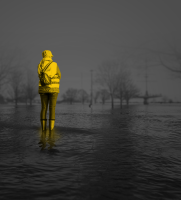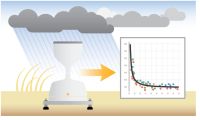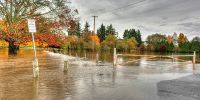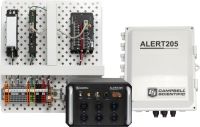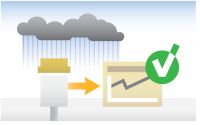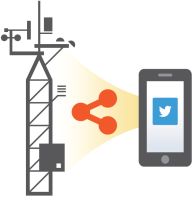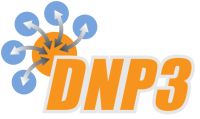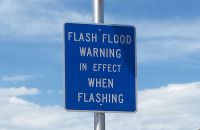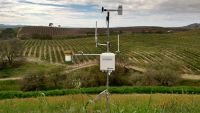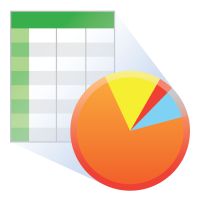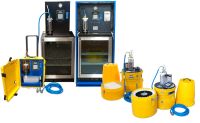Water Topics Your source for water-related articles
Displaying 1 - 13 of 13 articles
緊急管理者がより良い洪水警報システムを設計するための6つの必須事項
著者: Jamie McDonald | 最終更新日: 08/15/2025 | コメント: 0
洪水は、世界で最も被害が大きく、急速に広がる自然災害の一つです。人命と財産を守る緊急管理者にとって、適切に設計された洪水警報システムは単なるツールではなく、公共安全インフラの重要な一部です。 しかし、このようなシステムの設計やアップグレードは複雑な作業となる可能性があり、センサーや無線機だけでは不十分です。戦略的な計画、賢明な技術の選択、そして人々が警報通知にどのように反応するかについての深い理解が求められます。 このブログ記事では、信頼性が高く、拡張性があり、将来を見据えた洪水警報システムを構築する際に、緊急管理者が考慮すべき最も重要な 6 つの要素について、Campbell Scientific が考えるところを説明します。 #1 - リアルタイムで信頼性の高いデータ 河川水位が上昇すると、スピードが重要になりますが、データへの信頼性も同様に重要です。更新速度は速いものの断続的にしか更新されないシステム、あるいは通信障害によって重要な事象を見逃してしまうシステムは、有益どころか有害となる可能性があります。 悪条件下でも信頼性を確保するために構築されたテレメトリおよび通信プロトコルを選択することが重要です。多くの公共安全機関にとって、これは従来のALERTベースのシステムから、より現代的なALERT2プロトコルへの移行を意味しています。ALERT2は、時刻同期メッセージング、前方誤り訂正(FEC)、および高速データレートを提供します。これらのプロトコルの進歩により、嵐などインフラに負荷がかかる状況でも、データが確実に定期的に送信されるようになります。 重要なポイント:高速で信頼性が高く、困難な状況でも実証済みの通信プロトコルを選択します。 #2 - 地理的範囲とセンサーの配置 流域はどれも同じではありません。優れた洪水警報ネットワークは、地域の地形や水文特性に合わせて設計されます。つまり、洪水発生地点だけでなく、状況の変化によって早期の兆候を察知できる上流にもセンサーを設置する必要があります。 次の質問を使用してネットワークを評価します。 水位センサーは既知の洪水地帯に設置されていますか? あなたの河川監視センサーはすべての主要な支流をカバーしていますか? あなたのシステムは、流量や圧力の急激な変化を追跡できますか? カバレッジのギャップによりコミュニティが危険にさらされる可能性があるため、水文学的評価を実施して、センサーの影響が最も大きい場所を特定することができます。 重要なポイント:十分な情報に基づいた決定を下すために十分なデータを提供できるように、補償範囲が十分であることを確認してください。 #3 - 通信システムの自律性 洪水が発生すると、停電や携帯電話ネットワークの混乱が同時に発生することが多々あります。インターネットやモバイルデータのみに依存するシステムは、最も必要な時に機能しなくなる可能性があります。 こうした潜在的な障害に備えて、多くの緊急機関はALERT2などのプロトコルを使用する無線ベースのシステムへの投資を続けています。これらのシステムは、携帯電話やブロードバンドのインフラとは独立して動作し、メッシュまたはリピーター構成を備えたスタンドアロンネットワークとして機能します。接続性が限られている地域やインフラの喪失リスクが高い地域では、このような回復力は必須です。 重要なポイント:悪条件下でも信頼できる通信プロトコルを使用します。 #4 - 緊急時対応の統合 洪水警報システムは単独では効果を発揮しません。理想的には、地域の緊急対策センター(EOC)のダッシュボード、現場チーム向けのモバイルアプリ、あるいは一般市民への自動テキストアラートなど、より広範な緊急管理ワークフローに連携する必要があります。 以下を提供するシステムを探してください: リアルタイム可視化ツールまたはマップベースのダッシュボード しきい値ベースのアラームと通知 アラート通知プラットフォームとの統合のためのエクスポートオプション 適切なデータが適切な人に適切なタイミングで届けば、迅速なアクションにつながります。これらの機能を備えた、当社のWebベースの意思決定支援ソフトウェア、CampbellCloud™のご利用をご検討ください。 重要なポイント:より広範なネットワークで情報を共有し、公共の安全対策を改善します。 #5 - 保守性と寿命 テクノロジーは、複雑すぎたり、維持費が高すぎたりすると、地域社会に十分な貢献をしません。長期的な現場展開、最小限のメンテナンス、リモート診断レポート機能を備えた機器を慎重に選定してください。システムを標準化することも重要です。異なるソフトウェアやメンテナンススケジュールを必要とする、互換性のない機器の寄せ集めは避けましょう。 導入時の機器選定は、システムの将来的なニーズに大きな違いをもたらします。例えば、当社のAL200X ALERT2モデムおよびセンサーインターフェースは、 ALERT2に完全準拠し、複数のセンサーをサポートし、過酷な現場環境にも耐えうる堅牢な設計を備えています。AL200Xは、システムへの統合や設定が容易で、長年にわたり信頼性の高い運用が可能な設計となっています。 重要なポイント:現在と将来のニーズに合わせて計画を立てましょう。 #6 - 公共コミュニケーションと教育 技術的にどれほど優れた警報システムであっても、人々が警報の意味や行動すべきタイミングを理解していなければ、人命を救うことはできません。システムを設計する際には、警報情報が必要な人にどのように伝達されるかを検討してください。 警告はプラットフォーム(サイレン、モバイルアラート通知、ソーシャルメディア)間で一貫していますか? 言語は明確で理解しやすいですか? 災害が発生する前に、啓発活動や教育プログラムが実施されていますか? 十分な情報を得た国民は、警報通知を受け取ったときにより迅速かつ知識に基づいた行動をとることができ、安全を確保するためのより適切な判断を下すことができます。 重要なポイント:理解しやすく実用的な情報を求めるコミュニティ メンバーのニーズを考慮してください。 結論:全体的に考え、積極的に行動する 洪水警報システムの設計には、センサー、モデム、データロガーの選定以上の作業が必要です。緊急管理者や地域社会に必要な情報を最も必要な時に提供できる、統合型で信頼性の高い、人を中心としたネットワークを構築することが重要です。 次の 6 つの要素に注目してください。 リアルタイムで信頼性の高い通信 十分なデータ範囲 自律通信システム データ共有 堅牢な設備 国民の準備 ALERT2 プロトコルと AL200X などのコアデバイスを使用すると、現代の洪水リスクの現実に合わせて将来に備えたシステムを作成することがこれまで以上に簡単になります。 AL200X および Campbell Scientific のその他の洪水警報ソリューションの詳細については、洪水警報システム ソリューション ページをご覧ください。 クレジット: Campbell Scientific, Inc. の Brett... 続きを読むALERT2 が洪水警報の未来の波である理由
著者: Jamie McDonald | 最終更新日: 08/08/2025 | コメント: 0
洪水が発生すると、一秒一秒が重要です。激しい降雨により、河川の水位は瞬く間に洪水水位を超え、物的損害と人命救助の分かれ目は、警報システムの速度と信頼性にかかっています。従来のALERT(Automated Local Evaluation in Real Time)プロトコルは、洪水警報と環境監視のための信頼性の高いリアルタイムデータを提供してきましたが、進化する技術とネットワークの需要により、通信規格の近代化が求められています。 そこでALERT2プロトコルが登場します。1970年代から使用されてきたオリジナルのALERTプロトコルを近代化・拡張するために開発されたALERT2は、リアルタイム洪水警報システムのための、より信頼性が高く、高速で、拡張性の高い基盤を提供し、世界中の先進的な機関で使用されています。当社のAL200X ALERT2モデムおよびセンサーインターフェースなどのデバイスを活用すれば、この新しいプロトコルの導入がさらに容易になります。 ALERT2 の違いは何ですか? ALERT2は単なる小規模なアップグレードではありません。洪水警報ネットワークの通信方法における飛躍的な進歩です。最も重要な改良点の一つは、時分割多元接続(TDMA)アーキテクチャの採用です。このアーキテクチャは、ネットワーク全体の無線伝送を整理し、各局が放送専用のタイムスロットを割り当てられるようにします。これにより、特に信頼性の高い通信が不可欠となる暴風雨のピーク時において、旧来のシステムによく見られたメッセージの衝突やデータ損失が解消されます。 もう一つの重要な進歩は、内蔵の前方誤り訂正(FEC)です。この技術により、大雨や障害物によって信号が弱くなっても、メッセージは正確に伝達されます。GPSベースの同期(すべてのステーションが同じ正確なスケジュールで運用される)と組み合わせることで、ALERT2はより多くのデータをより短時間で、より少ないエラーで送信できる効率的なシステムを実現します。緊急事態管理者にとって、これは、携帯電話ネットワークがダウンしたり通信チャネルが飽和状態になったりした場合でも、タイムリーで完全かつ信頼性の高いデータによって状況認識を向上させることを意味します。 現場からの教訓 ALERT2の価値は理論的なものではありません。すでに重大な状況においてその真価が証明されています。 2017年のハリケーン・ハービーの際、ヒューストン地域に設置されたキャンベル・サイエンティフィックのALERT2ベースのシステムは、嵐の負荷によりモバイルネットワークが不安定になったにもかかわらず、継続的にリアルタイムの洪水データを提供しました。雨量と水位に関する情報が途切れることなく提供されることで、緊急管理者は情報に基づいた地域的な避難判断を下し、最も必要な時に地域社会を守ることができました。 おすすめ: 「テキサス: ハリケーン ハービー」のケース スタディをお読みください。 サクラメント地域洪水管理局(SAFCA)などの機関は、従来のALERTネットワークからALERT2ネットワークへの完全移行を完了しました。SAFCAの場合、このアップグレードにより、データの解像度が向上し、重大な事象発生時のシステム信頼性が向上しました。 おすすめ: ALERT2 システムを含む サクラメント市の「総合洪水管理計画」をお読みください。 オーストラリアでは、ALERT2プロトコルがブリスベン市の防災力向上の取り組みの礎となっています。2022年の洪水を受けて、市が委託した調査では、緊急時の連携強化のため、早期警報システムとテレメトリーの拡充の重要性が強調されました。具体的なプロトコルは明記されていませんが、報告書の推奨事項はALERT2が既に提供している多くの機能を反映しています。 おすすめ:「ブリスベン市議会 2022 年洪水レビュー」をお読みください。 AL200XでALERT2の導入が簡単に Campbell Scientific の AL200X は、現場での ALERT2 の導入を簡素化するために特別に設計されています。 AL200Xは、最も過酷な環境でも動作するように設計されたモデムおよびセンサーインターフェースです。雨量、水位、圧力など、幅広いセンサーに対応しています。TDMA、GPS同期、FECを含むALERT2仕様に完全準拠しています。コンパクトで堅牢な設計で、既存のインフラへの統合が容易です。単一のサイトのアップグレードから地域ネットワーク全体の近代化まで、あらゆるニーズに対応します。また、耐久性を考慮した部品を用いてゼロから構築されています。 緊急管理者にとって、これはハードウェアの構成に費やす時間が減り、コミュニティの準備、受信データの解釈、自信を持って対応活動を調整するといった重要なことに集中できる時間が増えることを意味します。 自信を持って近代化 洪水はますます頻繁に発生し、深刻化し、予測が困難になっています。最新の洪水警報システムはもはや贅沢品ではなく、必需品です。ALERT2は、緊急管理者が嵐に先手を打つために必要なスピード、信頼性、そして柔軟性を提供します。AL200Xのようなツールがあれば、このテクノロジーの導入は今や容易なものとなります。 AL200X の詳細と、それが洪水警報システムのより迅速な警報とよりスマートな対応の中心となる仕組みについては、当社のAL200X 製品 Web ページをご覧ください。 クレジット: Campbell Scientific, Inc. の Brett Hansen がこの記事に貢献しました。 続きを読むあなたの未来に、革新的なアップグレードはありますか?
著者: Brett Hansen | 最終更新日: 06/04/2025 | コメント: 0
水文学者や緊急管理者として、洪水警報システムからより高速で信頼性が高く、高解像度のデータを取得したいとお考えですか?現在お使いのシステムがALERTプロトコルを使用している場合は、ALERT2プロトコルを使用するシステムにアップグレードする絶好の機会かもしれません。この記事では、ALERT2プロトコルとALERT2の違いと、アップグレードがもたらす影響について説明します。 ご存知のとおり、洪水警報システムは公共の安全にとって極めて重要であり、特に異常気象が頻発し、深刻化している状況においてはなおさらです。数十年にわたり、ALERT ( Automated Local Evaluation in Real Time )システムは、米国とオーストラリアの多くの洪水監視ネットワークの基盤となってきました。ALERTプロトコルは、暴風雨時に降雨量と河川データを迅速に収集・伝送するための基盤を築きました。 より高速で信頼性が高く、高解像度のデータに対する需要が高まるにつれ、従来のALERTの限界がますます明らかになっていきました。これが、緊急管理者、水文学者、そして地域社会の洪水対応方法を変革する近代化されたプロトコル、ALERT2の誕生につながりました。 ALERTプロトコルの理解 1970年代後半から1980年代初頭にかけて開発された従来のALERTプロトコルは、遠隔地に設置されたセンサーからアナログUHFおよびVHF無線を介して基地局へリアルタイムでデータを直接送信できるようにすることで、洪水警報に革命をもたらしました。ALERTはすぐに、緊急管理機関や水資源局の標準となりました。 遅い送信速度 – ALERT は比較的低いボー レート (300 bps) で動作するため、特に複数のセンサーが同時に送信しようとすると、データ配信速度が低下します。 限られたセンサー ID プール – 使用できる一意の ID は 8,192 個のみであるため、高密度ネットワークに展開できるセンサーの数が制限されます。 制約されたデータ解像度 - ALERT はデータを整数として送信し、値を 0 から 2,047 までに制限します。これにより、最新の水文学的分析に必要な粒度と精度が制限されます。 データの損失 – ALERT には衝突回避機能がなく、ALOHA スタイルの通信を使用するため、異なるセンサーからのメッセージが重複する可能性があり、信頼性の高いデータの受信が最も重要な高トラフィック イベント中にデータが失われることがあります。 ALERT2プロトコルの利点 ALERT2プロトコルは、従来のALERTの限界が拡大する中で、国家水文警報委員会(NHWC)とALERTユーザーズグループ(AUG)の協力のもと、2010年に導入されました。最新のデジタル通信規格を採用することで、パフォーマンスと信頼性を大幅に向上させています。 ALERT2 の主な利点は次のとおりです。: より高速な伝送速度 - ALERT2 は最大 4,800 bps... 続きを読むWhy Do We Need an Algorithm for Rainfall Intensity Correction?
著者: Dirk Baker | 最終更新日: 03/05/2021 | コメント: 0
In this article, I’ll explain how errors can occur when measuring the precipitation amount, discuss a correction approach, and demonstrate how an algorithm can be used to design high-quality tipping bucket rain gauges. Introduction Liquid precipitation (rain) is at once one of the simplest measurements mechanically and... 続きを読むMaking Real-Time Crest Measurements
著者: Mike Nelson | 最終更新日: 09/08/2020 | コメント: 0
There are times during major weather events when we may hear the news reporter indicate the local river is expected to crest in the next 12 hours at an estimated stage level. What is a crest and a stage level, and how do they affect me? Basically,... 続きを読むWhy Compromise if You Don’t Have to?
著者: Ryan Guerrero | 最終更新日: 05/29/2020 | コメント: 0
It’s 2020, and yet those of us who need water level monitoring and flood warning systems continue to face the quandary of choosing between easy-to-use stations OR flexible stations that can handle all our measurement and control needs. In the years of self-driving cars and telecommuting jobs,... 続きを読むHow to Easily Test Your Rain Gauge Calibration—and Avoid Errors
著者: Mike Nelson | 最終更新日: 02/28/2019 | コメント: 4
Testing the calibration of your rain gauge is a simple process. But as you know, it’s also easy to introduce problems, such as incorporating simulated data as real data. In this article, we’ll review a useful feature that automates the testing process and can help... 続きを読むSharing Your Monitored Data via Social Media
著者: Barbra Utley | 最終更新日: 10/28/2016 | コメント: 0
Whether you measure and monitor conditions for flooding, road weather, aviation, fire, or avalanches, your data is important to you and those with whom you share it. Oftentimes, sharing your data quickly is critical, as conditions may change rapidly and require prompt action. In this... 続きを読むGetting to Know DNP3
著者: Paul Smart | 最終更新日: 01/20/2016 | コメント: 0
Have you heard of DNP3 but been unsure of what it is or what it’s used for? In this brief article, I’ll introduce you to this communications protocol, its role in SCADA applications, and how you can use it with your Campbell Scientific equipment and... 続きを読むUsing Internet Data to Promote Outdoor Safety
著者: Barbra Utley | 最終更新日: 11/04/2015 | コメント: 0
When it comes to weather conditions, looks can be deceiving. An area that appears to be experiencing mild weather may soon experience conditions that are dangerous to human life. How can you prepare for rapidly changing weather conditions and ensure the safety of those in... 続きを読むMeet Our 2015 Photo Contest Winners
著者: Robin Deissinger | 最終更新日: 10/28/2015 | コメント: 4
We asked our integrators, those folks who sell and install our products, to send us their best photos of Campbell Scientific equipment operating in the field. From all of their submissions, we selected a photo from Western Weather Group as the first-place winner. Runners-up photo... 続きを読むCRBasic Tips to Simplify Data Post-Processing
著者: Barbra Utley | 最終更新日: 08/12/2015 | コメント: 3
You’ve collected your measurement data, but how do you easily make sense out of it? How can you simplify the post-processing of your data and start analyzing it sooner? In this article, I’ll explain how adding some code to your CRBasic program can save you... 続きを読むAutomatic Water Sampler Maintenance Tips
著者: Robin Deissinger | 最終更新日: 07/29/2015 | コメント: 1
If you use automatic water-sampling equipment, consider performing a maintenance check-up during the month of August, which is National Water Quality Month in the U.S. When you perform a maintenance check-up, you can help ensure that your equipment is operating at an optimal level and that you... 続きを読む













